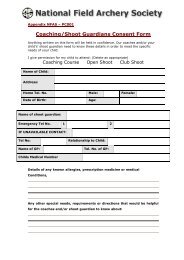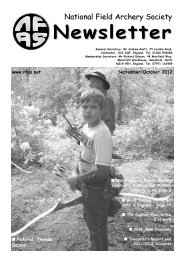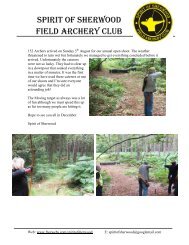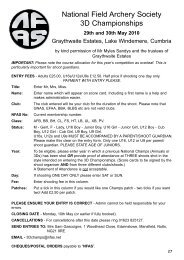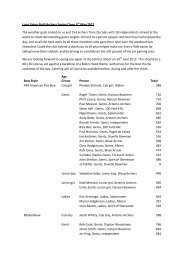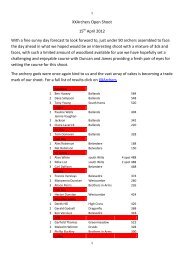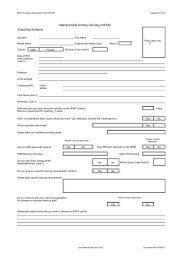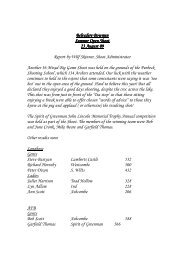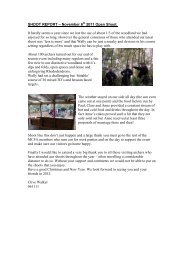NFAS SAFETY RULES – 2010-11 - National Field Archery Society
NFAS SAFETY RULES – 2010-11 - National Field Archery Society
NFAS SAFETY RULES – 2010-11 - National Field Archery Society
Create successful ePaper yourself
Turn your PDF publications into a flip-book with our unique Google optimized e-Paper software.
<strong>NFAS</strong> <strong>SAFETY</strong> <strong>RULES</strong> <strong>–</strong> <strong>2010</strong>-<strong>11</strong><br />
The rules and guidance below came into force on 1 st April <strong>2010</strong> and replace all previous rules<br />
and guidance.<br />
Safety Policy<br />
“The <strong>National</strong> <strong>Field</strong> <strong>Archery</strong> <strong>Society</strong> (<strong>NFAS</strong>) exists to foster and promote <strong>Field</strong> <strong>Archery</strong> in all its<br />
forms. The General Committee of the <strong>NFAS</strong> will carry out the affairs of the <strong>Society</strong> with due<br />
respect for the environment and the health, safety and welfare of its Members and others who<br />
may be affected. The <strong>NFAS</strong> is committed to the promotion of best practice amongst its<br />
membership and as such will take steps to communicate this and ensure that all Members<br />
may draw from the experience of others. The <strong>NFAS</strong> will devise and maintain systems to<br />
achieve its aims and comply with the law. Where appropriate the <strong>NFAS</strong> will consult and<br />
involve the Membership. All members have a responsibility for safety and the <strong>Society</strong><br />
depends on the compliance of individuals to ensure these safety standards are met.”<br />
Because a bow and arrow is a lethal weapon every member of the <strong>Society</strong> is responsible for<br />
ensuring that she/he shoots safely. All members are expected to intervene and take<br />
constructive action where she/he identifies unsafe situations caused by another archer or a<br />
course.<br />
Learning from safety issues<br />
The <strong>NFAS</strong> Safety Advisor will publish information about all shots perceived as dangerous,<br />
Near Hit incidents and accidents in the <strong>NFAS</strong> Newsletter, giving the nature of the incident so<br />
that all archers can learn from the experiences of others (see rules 1-5).<br />
Rules about shooting safety<br />
1) It is the responsibility of each archer to ensure that others in the group are shooting safely<br />
and in accordance with <strong>NFAS</strong> rules.<br />
2) Archers must report dangerously laid targets, dangerous behaviour and Near Hit incidents<br />
to course officials or marshals at the earliest opportunity.<br />
3) Archers must report accidents to course officials or marshals immediately.<br />
4) Course officials and/or marshals must investigate immediately any report of dangerously<br />
laid targets, dangerous behaviour, Near Hit incidents and accidents made by archers and<br />
take necessary steps to reduce any hazard.<br />
4a) Any non-archer who accompanies an archer around a course, whether as a shoot<br />
guardian or observer, must be an Associate Member of <strong>NFAS</strong> in order to benefit from<br />
<strong>NFAS</strong> insurance cover. Such an individual must follow all applicable <strong>NFAS</strong> safety rules.<br />
Any marshal or course official at an open or friendly shoot must be a <strong>NFAS</strong> member.<br />
5) All dangerously laid targets, dangerous behaviour, Near Hit incidents and accidents must<br />
be reported by all the archers witnessing these incidents to the <strong>NFAS</strong> Safety Advisor<br />
within seven days, regardless of any subsequent action taken by course organisers. It is<br />
unfair to report any issue only to the <strong>NFAS</strong> Safety Advisor without having raised the same<br />
issues with the shoot organiser or a marshal.<br />
6) Archers should always ensure that the target and visible overshoot are clear of other<br />
archers before shooting. If you have concerns about the safety of a shot, do not shoot.<br />
7) Whilst someone else is shooting be alert for possible danger. Where possible danger<br />
exists shout “stop”. On hearing “stop” all members of the group must stop shooting<br />
immediately.<br />
1
8) Never point or loose an arrow in any direction other than at the intended target.<br />
9) Never point an arrow at a person and never shoot to the side of a person.<br />
10) Never point a bow <strong>–</strong> whether loaded or unloaded - at anyone.<br />
<strong>11</strong>) Never knowingly shoot a damaged arrow.<br />
12) Never move between targets with an arrow nocked on the string.<br />
13) Bows must not be drawn in a manner where an accidental release could be dangerous<br />
(eg a high draw).<br />
14) It is only permitted to physically assist another archer where there is a genuine safety<br />
issue, eg high wind, dazzling sun or slippery terrain. This can only be done with the<br />
unanimous agreement of all members of the shooting group and only if there is no risk to<br />
the archer, the person providing the assistance and all other members of the group.<br />
15) Every adult archer must carry a whistle:<br />
a) In the event of an emergency or accident, only one capable person (normally an<br />
adult) shall use a whistle to give the emergency signal of three blasts followed by a<br />
pause.<br />
b) On hearing the emergency signal, all archers must stop shooting immediately.<br />
c) The emergency signal shall be repeated only by one of the group originating the<br />
signal until the shoot organiser or a marshal arrives at the scene.<br />
d) On hearing the emergency signal any other persons on the shoot site (such as<br />
caterers, trade stalls etc) should stay where they are until told otherwise by the shoot<br />
organiser or a marshal.<br />
e) The shoot organiser and marshals, on hearing the emergency whistle signal, shall<br />
immediately sound the shoot’s ‘stop shooting’ signal, which should also be three<br />
blasts. The source of this signal (eg an air horn) must be announced to archers in<br />
the shoot organiser’s pre-shoot safety briefing.<br />
f) Only the shoot organiser can restart the shoot (with the information passed on by<br />
marshals if necessary). The restart signal is normally one blast of the same source<br />
(eg an air horn) used to stop the shoot which should also be highlighted at the preshoot<br />
safety briefing. A whistle must not be used to restart a shoot.<br />
16) No one should be on a <strong>NFAS</strong> course under the influence of alcohol or drugs. Archers<br />
should not be under the influence of any medication which causes drowsiness whilst<br />
shooting. Advice can be sought from a medical practitioner or pharmacist if there is any<br />
uncertainty about whether any medication affects an archer’s ability to shoot safely.<br />
17) It is the responsibility of parents/guardians and shoot organisers to ensure that the <strong>NFAS</strong><br />
Child Safety Policy is followed for all archers under the age of 16.<br />
18) No one in a group is permitted to stand forward of the archer on the shooting peg<br />
(including no forward spotting).<br />
19) Do not alter the setting of the shot. If you believe there is a safety issue alert the shoot<br />
organiser or marshal.<br />
20) Give the archer on the peg sufficient room to avoid creating a safety hazard or distracting<br />
the archer.<br />
21) When scoring, drawing or looking for lost arrows, at least one adult member of a group<br />
must remain standing in front of the target.<br />
22) Walk away from the target as a group and never go back to the target.<br />
2
23) Always keep to the marked path when moving from one target to the next. The marked<br />
path should also be followed when a round has been completed because other groups<br />
may still be shooting.<br />
3
Safe equipment guidance<br />
Whilst not rules, it is strongly recommended that the following are adhered to:<br />
a) All archers should follow manufacturer’s instructions for minimum arrow spine and weight<br />
and ensure a spine and weight is used which is safe for the model and draw-weight of<br />
bow being used.<br />
b) All archers should follow manufacturers’ safety instructions and recommendations for all<br />
equipment to be used safely.<br />
c) All archers should consider wearing at least one piece of highly visible clothing or<br />
headgear that makes it easier to be seen by other archers.<br />
d) It is good practice to check an arrow for damage each time it is shot.<br />
Rules about course laying<br />
24) All courses must be evaluated for safety risks prior to a shoot by a responsible individual<br />
or individuals who will take the necessary action to make a shoot as safe as possible.<br />
25) Any potential hazards (for example potentially slippery bridges, rabbit holes) identified<br />
when evaluating course safety risks (rule 24) must be highlighted to archers in a preshoot<br />
safety briefing.<br />
26) Every shot must have a clear shooting window or windows which makes the shot<br />
potentially hittable for all types of bows and all archers shooting from that peg. This does<br />
not require there to be a clear lane.<br />
27) Shooting pegs should be positioned in as straight a line as possible to the target to<br />
maximise the effectiveness of backstops and overshoots and reduce the risk of damage<br />
to arrows.<br />
28) Safe overshoots must be provided for all targets taking into account different bow types,<br />
the potential for deflections and the terrain (for example a longer overshoot will be<br />
required if the ground drops away).<br />
29) Sufficient sideways separation between targets must be allowed, taking into account<br />
different bow types, the potential for deflections and the terrain. Greater distance for<br />
sideways separation must be allowed for long shots or shots involving shooting through<br />
gaps in or between trees, where there is greater risk of deflections occurring.<br />
30) Do not set out targets where the direction of shooting faces towards areas used by the<br />
general public (eg roads, public footpaths) unless a safe overshoot can be provided.<br />
31) Enough space must be provided for three members of a group to stand in front of the<br />
target to score and pull arrows.<br />
32) Course direction markers must be clearly marked along the whole route.<br />
33) The path to the next target must bring archers in behind the furthest peg.<br />
Course laying guidance<br />
Whilst not rules, it is strongly recommended that the following are adhered to:<br />
e) At least one person laying a course should have previous experience of assisting in laying<br />
a minimum of four courses.<br />
f) Courses should be tested in advance of a competition by as many different bow types (eg<br />
compounds, longbows) and different physical types of archers (eg tall, short, righthanded,<br />
left-handed) as possible.<br />
g) Walk-away routes from targets should, where achievable, be at 90° from the line of the<br />
shot.<br />
4
h) Bosses used are to be positioned to reduce deflections, for example with wooden<br />
supports at the side and not the top and bottom.<br />
i) Consider having a sign at each target containing the name of the animal to be shot which<br />
is visible to archers waiting to shoot that target.<br />
It is also recommended that course layers refer to the <strong>NFAS</strong> ‘Club Pack’.<br />
Rules about organising shoots<br />
34) The shoot organiser must provide a safety briefing prior to each shoot commencing,<br />
identifying any high risk matters (see rule 25), information about what to do in case of an<br />
accident (first aid and instructions for stopping/restarting the shoot in case of an accident<br />
<strong>–</strong> also see rule 15), whether smoking is allowed and what signal will be used to start the<br />
shoot.<br />
35) The shoot organiser must ensure that course officials and marshals have safety<br />
information to use in the case of an emergency. This would normally include: map<br />
reference for the shoot; the name of the access road(s); the address of the nearest<br />
Accident & Emergency hospital; the nearest helicopter landing site (if applicable).<br />
36) The shoot organiser (or a delegated person) must see current <strong>NFAS</strong> membership cards<br />
from every archer when signing into a shoot. If an archer does not have a current <strong>NFAS</strong><br />
membership card, temporary membership must be taken out. Temporary membership<br />
requires a witness to state that an archer is a ‘competent archer’ as defined by <strong>NFAS</strong><br />
‘membership rules’.<br />
Shoot organisation guidance<br />
Whilst not rules, it is strongly recommended that the following are adhered to:<br />
j) Details of the location of the shoot (eg map reference and access routes in/out of shoot)<br />
are provided to the emergency services and revalidated with the emergency services on a<br />
regular basis.<br />
k) A scale map of the course, showing the location of individual targets is prepared for use<br />
by the shoot organisers and emergency services.<br />
l) All shoots should have a suggestion box and archers should be encouraged to provide<br />
their views <strong>–</strong> verbally or via the suggestion box about good and bad points of the course<br />
so that the course organisers can learn for the future. Suggestions made should be<br />
evaluated by shoot organisers on a regular basis.<br />
Course etiquette guidance<br />
Whilst not rules, it is recommended that the following course etiquette be observed:<br />
m) Keep well back from the group in front.<br />
n) Keep noise down.<br />
o) Turn off mobile phones.<br />
p) Respect other archers and allow them to execute their shots without disruption.<br />
q) Be tolerant of archers shooting a different bow style from you.<br />
r) Help others to pull or find their arrows.<br />
s) Keep children and dogs under close control.<br />
t) Be polite to course officials, marshals and members of the public.<br />
u) Keep courses free from litter and respect the course owner's property.<br />
5
v) If archers see queues forming at the target ahead, ensure that there is space at the next<br />
target to wait before moving on.<br />
6



